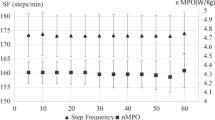Abstract
The present study was designed to study intra-individual step variability measured both on vertical displacement of the body (ΔZ) and on step time (Δt) parameters by means of a kinematic arm and during treadmill running. A group of 17 subjects ran successively at 60%, 80%, 100% and 140% of their maximal aerobic velocity (v amax). The total number of steps analysed was 6116. The absolute ΔZ step variability (σΔZ) ranged between 5 mm and 21 mm while the absolute Δt variability (σΔt) ranged between 6 ms and 40 ms. Step variabilities were due to step asymmetry (from 38.5% to 48.5% of the step variability) and to stride variability. For submaximal velocities (60%, 80%, and 100%v amax) both σΔt and σΔZ were independent of velocity or body dimensions whereas differences between subjects were significant (P < 0.01) for σΔZ. On the other hand, variabilities were significantly increased when velocity was changed from submaximal to the 140%v amax level. Furthermore, at submaximal levels σΔZ was linked to the subject's energy cost of running (P < 0.05). Therefore, the intra-individual step variability should not be neglected in future studies on mechanical efficiency of running and it is suggested that, to obtain a good accuracy (better than 1%,P < 0.05) on mean value and variability of the mechanical parameters, measurements should be performed on at least 32–64 consecutive steps, which corresponds to about 15 to 20 s of running.
Similar content being viewed by others
References
⫗Astrand P-O, Rodhal K. (1986) Textbook of work physiology, 3rd edn. McGraw-Hill, New York, pp 543–556
Bates BT, Osternig LR, Mason BR, James SL (1979) Functional variability of lower extremity during the support phase of running. Med Sci Sports Exerc 11:328–331
Bates BT, Osternig LR, Sawhill JA, James SL (1983) Assessment of subject variability, subject-shoe interaction, and the evaluation of running shoes using ground reaction force data. J. Biomech 16:181–191
Belli A, Bosco C (1992) Influence of stretch-shortening cycle on mechanical behaviour of triceps surae during hopping. Acta Physiol Scand 144:401–408
Belli A, Rey S, Bonnefoy R, Lacour JR (1992) A simple device for kinematic measurements of human movements. Ergonomics 27:285–287
Belli A, Avela J, Komi PV (1993) Mechanical energy assessment with different methods during running. Int J Sports Med 14:252–256
Bourdin M, Pastene J, Germain M, Lacour J-R, (1993) Influence of training, sex, age and body mass on the energy cost of running. Eur J Appl Physiol 66:439–444
Cavagna GA (1975) Force platforms as ergometers. J Appl Physiol 39:174–179
Cavanagh PR (1990) Biomechanics: a bridge builder among the sport sciences. Med Sci Sports Exerc 22:546–557
Cavanagh PR, Kram R (1989) Stride length in distance running: velocity, body dimensions, and added mass effects. Med Sci Sports Exerc 21:467–479
Cavanagh PR, Pollock ML, Landa J (1977) A biomechanical comparison of elite and good distance runners. The marathon: physiological, epidemiological, and psychological studies. Ann NY Acad Sci 301:328–345
Cavanagh PR, Andrew GC, Kram R, Rodgers MM, Sanderson DJ, Henning EM (1985) An approach to biomechanical profiling of elite distance runners. Int J Sports Biomech 1:36–62
di Prampero PE (1986) The energy cost of human locomotion on land and in water. Int J Sports Med 7:55–72
Fenn WO (1993) Work against gravity and work due to velocity changes in running. Am J Physiol 93:433–462
Ingen Schenau GJ van (1980) Some fundamental aspects of the biomechanics of overground versus treadmill locomotion. Med Sci Sports Exerc 12:257–261
Lacour J-R, Padilla-Magunacelaya S, Barthelemy J-C, Dormois D (1990) The energetics of middle distance running. Eur J Appl Physiol 60:38–43
Luhtanen P, Komi PV (1978) Mechanical factors influencing running speed. In: Asmussen E, Jorgensn K (eds) Biomechanics VI-B. University Park Press, Baltimore; pp 23–29
Morgan DW, Martin PE, Krahenbuhl GS (1989) Factors affecting running economy. Sports Med 7:310–330
Nicol C, Komi PV, Marconnet P (1991) Fatigue effects of marathon running on neuromuscular performance. I. Changes in muscle force and stiffness characteristics. Scand J Med Sci Sports 1:10–17
Nilsson J, Thortensson A (1987) Adaptability in frequency and amplitude of leg movements during human locomotion at different speeds. Acta Physiol Scand 129:107–114
Rack MH (1981) Limitations of somatosensory feedback in control of posture and movement. In: Brooks V (ed) Handbook of physiology, the nervous system, vol. II Motor control. Williams and Wilkins, Baltimore, pp 229–256
Renault J (1991) Intervalle de confiance de l'estimation d'une espérance. Formulaire de probabilites et de statistiques. Dunod, Paris, pp 93–94
Shephard RJ (1992) Maximal oxygen intake. In: Shepard RJ, ⫗Astrand PO (eds) Endurance in sport, Blackwell Scientific Publications, Oxford; pp 192–200
Vagenas G, Hoshizaki B (1992) A multivariable analysis of lower extremity kinematic asymmetry in running. Int J Sports Biomech 8:11–29
Williams KR, Cavanagh PR (1987) Relationship between distance running mechanics, running economy and performance. J Appl Physiol 63:1236–1245
Williams KR, Snow RE, Jones JE (1989) A comparison of distance running kinematics between treadmill and competitive running and between genders. In: Gregar RJ, Zeknicke RF, Whiting WC (eds) Proceedings of XIIth Congress of International Society of Biomechanics [Abstr 139] Los Angeles, USA
Author information
Authors and Affiliations
Rights and permissions
About this article
Cite this article
Belli, A., Lacour, J.R., Komi, P.V. et al. Mechanical step variability during treadmill running. Europ. J. Appl. Physiol. 70, 510–517 (1995). https://doi.org/10.1007/BF00634380
Accepted:
Issue Date:
DOI: https://doi.org/10.1007/BF00634380




